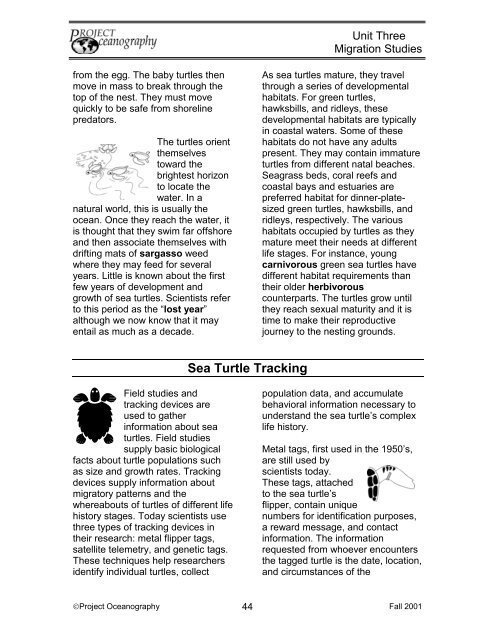Sea Turtles
Sea Turtles
Sea Turtles
You also want an ePaper? Increase the reach of your titles
YUMPU automatically turns print PDFs into web optimized ePapers that Google loves.
Unit Three<br />
Migration Studies<br />
from the egg. The baby turtles then<br />
move in mass to break through the<br />
top of the nest. They must move<br />
quickly to be safe from shoreline<br />
predators.<br />
The turtles orient<br />
themselves<br />
toward the<br />
brightest horizon<br />
to locate the<br />
water. In a<br />
natural world, this is usually the<br />
ocean. Once they reach the water, it<br />
is thought that they swim far offshore<br />
and then associate themselves with<br />
drifting mats of sargasso weed<br />
where they may feed for several<br />
years. Little is known about the first<br />
few years of development and<br />
growth of sea turtles. Scientists refer<br />
to this period as the “lost year”<br />
although we now know that it may<br />
entail as much as a decade.<br />
As sea turtles mature, they travel<br />
through a series of developmental<br />
habitats. For green turtles,<br />
hawksbills, and ridleys, these<br />
developmental habitats are typically<br />
in coastal waters. Some of these<br />
habitats do not have any adults<br />
present. They may contain immature<br />
turtles from different natal beaches.<br />
<strong>Sea</strong>grass beds, coral reefs and<br />
coastal bays and estuaries are<br />
preferred habitat for dinner-platesized<br />
green turtles, hawksbills, and<br />
ridleys, respectively. The various<br />
habitats occupied by turtles as they<br />
mature meet their needs at different<br />
life stages. For instance, young<br />
carnivorous green sea turtles have<br />
different habitat requirements than<br />
their older herbivorous<br />
counterparts. The turtles grow until<br />
they reach sexual maturity and it is<br />
time to make their reproductive<br />
journey to the nesting grounds.<br />
<strong>Sea</strong> Turtle Tracking<br />
Field studies and<br />
tracking devices are<br />
used to gather<br />
information about sea<br />
turtles. Field studies<br />
supply basic biological<br />
facts about turtle populations such<br />
as size and growth rates. Tracking<br />
devices supply information about<br />
migratory patterns and the<br />
whereabouts of turtles of different life<br />
history stages. Today scientists use<br />
three types of tracking devices in<br />
their research: metal flipper tags,<br />
satellite telemetry, and genetic tags.<br />
These techniques help researchers<br />
identify individual turtles, collect<br />
population data, and accumulate<br />
behavioral information necessary to<br />
understand the sea turtle’s complex<br />
life history.<br />
Metal tags, first used in the 1950’s,<br />
are still used by<br />
scientists today.<br />
These tags, attached<br />
to the sea turtle’s<br />
flipper, contain unique<br />
numbers for identification purposes,<br />
a reward message, and contact<br />
information. The information<br />
requested from whoever encounters<br />
the tagged turtle is the date, location,<br />
and circumstances of the<br />
©Project Oceanography 44<br />
Fall 2001
















